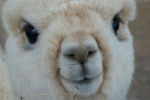Articles by Alpaca World Magazine:
Alpacas - why bother?
John Gaye
There are three million alpacas in South America, why is there a need for the animals to be bred elsewhere? There is a very successful alpaca fibre processing and manufacturing business in Peru, why should anyone want to set up a business in the UK? If you can purchase raw fibre very cheaply direct from Peru why should you buy these expensive animals for fleece production elsewhere? These are all very natural questions which the new owner might very reasonably be expected to ask.
The answers can be best found through a visit to the altiplano of Peru. Here you will see vast herds of alpacas quietly grazing away on the 'bofedale', that is the relatively fertile marshy area formed by the run off from the glaciers. You will see that the bofedale is however limited to the valley bottoms and outside of the valleys it is pure desert with very little to sustain a grazing animal. This is the natural habitat of the alpaca and without vast expensive irrigation schemes there is little scope for the alpaca farmer in Peru to expand his herd, he just does not have the land on which to do it.
Perhaps while you are there you will meet the buyer of the alpaca farmer's fleeces. He will pay according to weight and throw the fleeces into the back of his truck where they will mix with hundreds of others already purchased - the payment will not be great, a dollar or less per kilo. There is no incentive provided for the better quality fleece and there is no grading of it prior to payment.
You may be privileged to visit the grading and sorting house of one of the alpaca processors in Arequipa, the centre of the alpaca processing business. Here you will find dozens of native Peruvian ladies with face masks and aprons quietly sorting the various fleeces that the buyers have brought in from the altiplano. They will be surrounded by mountains of fibre all sorted by colour and they will spend all their day grading by hand each part of each fleece. On average it will take them 30 minutes to sort and grade a fleece. Of course at this stage there is no traceability of the owner of each fleece.
There is no incentive for the alpaca breeder to improve the quality of his fleeces. He has no room for expansion of his herd and although he will cull the worst of his animals in order to make room for younger better quality ones there is really nothing to encourage him to breed up his overall herd qualities. As a result the visitor to Peru will be surprised to find that the average animal is no better than those at home. That is not to say that better animals do not exist - they are however limited to a few very select breeders who have the resources and the wherewithal to appreciate that there is a market for better quality animals producing more and better fleece.
The alpaca processing and manufacturing companies in Arequipa use the very latest in textile technology. Their combing, scouring and spinning facilities are very impressive to see. Their design and manufacturing techniques are as up to date and advanced as you will find anywhere in Europe. However they all rely on one very traditional old fashioned technique and that is the little lady doing all the grading and sorting of the fleece prior to it going anywhere near modern technology. Without her essential work the system would not work. These graders are often employed for life having inherited their skills from their mothers before them and they continue to pass on the skills to their daughters (no equal rights here!). Labour is cheap and consequently the work that they do, no matter that it is critical to the whole operation, does not cost a great deal.
So after seeing all these vignettes from the Peruvian alpaca scene you may question why many hundreds of people in the USA, Canada, Australia, New Zealand and Europe have thought it a worthwhile enterprise to import to their own countries, and ask how the First World should compete with this? It cannot afford to pay for the labour of graders taking 30 minutes per fleece and consequently it must come up with a way to overcome this problem if the industry is going to be a viable fibre production enterprise, rather than just an animal breeding enterprise.
It is important that the new alpaca enterprise of the UK does not try to re-invent the wheel in finding a solution. Other fibre industries, including of course the wool industry, have overcome the grading problem and it is to these industries that we should look. They have concentrated on breeding up their herds to a point where farms have a reputation for producing consistently a certain quality of product. In the Australian Merino Wool industry farms concentrate on producing one wool type, be it fine, medium or strong. The farmers grade their own fleeces, or get a professional wool classer to do it, and bale them accordingly. The wool is then transported to a wool selling point where he has the option for more objective measurements. The test results are then printed so that the potential buyer can select the quality of wool most suited to the end product. The farmer is then paid according to the quality of his product; thus there is an incentive for him to make the effort to improve on both his breeding and on his fibre presentation.
The alpaca industry, if it is to be a viable industry in the long term, must also look to the qualities of its animals. I hope it goes without saying that breeders will endeavour to improve on the conformation of their animals but in addition they must concentrate on improving across the board the quality of their fibre. To do this they must learn about fibre and the qualities that are required. Many papers have been written about these qualities by people better qualified than me. However there still seems to be a tendency to concentrate on one aspect - that of the micron count. Mike Safley, of North West Alpacas in Oregon and one of the leading breeders of the USA, has for many years tried to dissuade people from this 'micron madness' . It is the easy way out to take a young animal, clip a sample from its mid-side, send it off to a laboratory for analysis and then rely on its results to judge the overall quality of the fleece.
There is so much more than just micron count. A 19 micron fibre could be flat, characterless and lacking any form of 'handle' - as such it might be graded not as 'Superfine' or 'Baby' but as medium. To the textile trade it will be limited in its uses if it is not to degrade the luxurious feel of an expensive up-market garment.
In addition consistency is important. Most young animals should produce a useable quality of fibre. However the sensible breeder will want to expand the useful quality production time of that animal. To produce a consistent quality of fibre the animal must have it in its genetic background. To take an alpaca from the altiplano, where it has been on low nutrient fodder, and then to expect it to produce the same quality of fibre on British, American or Australian pastures it must be genetically sound. The easy way to ensure this is to look at the consistency of its ancestry. If there are no records available then other ways must be found. One of these techniques, which is being pioneered in Australia, is to look to the skin follicles and, rather than take fibre samples, they will take skin samples for analysis. Now this technique needs specialist skills, however even the non-specialist can utilise their knowledge by examining the qualities of the fibre and looking for specific signs. Then by careful breeding a very ordinary herd can be up lifted very quickly by selecting males that will complement the female's qualities.
This is not to de-value the 'ordinary' alpaca, however its values will lie not from the production of quality fibre from its fleece but rather as a herd multiplier using well-selected quality males to improve the overall quality of the expanding herd. The vital ingredient lies in the quality of the male. In Peru there are specific breeding lines which are respected throughout the alpaca industry worldwide. Some of these lines have been exported to the USA and to Australia. Some even have found their way to the UK. Once again having the line in the genetic background of the animals is not to say that they will be guaranteed to be outstanding in their own right. Each animal must be looked at very carefully to ensure that it has the qualities that will benefit and complement the female he is covering. There may well be undesirable traits inherited from other lines which may predominate over its other qualities.
We in the UK industry are fortunate in that both the USA and Australia are more advanced than we are in the genetic improvement of some herds. In both countries there are breeders who have taken infinite care in the selection of their animals and their breeding lines over many years, they have kept accurate records and have selected males carefully to complement the qualities of the female. Certainly both countries have their fair share of the 'ordinary' but their best quality herds are way ahead of ours and we must recognise that fact. The real advantage of looking to these countries, rather than just to the select lines of Peru, is that they have been bred and brought up on good quality pasture and thus the genetic strengths of those animals will be more apparent than those which have been kept out on the low nutrient pasture of the altiplano. The full genetic potential of an animal is only realised when it is receiving its full dietary requirements. The best animals with the best genetic strengths will not lose their fibre qualities.
So to answer the questions posed at the start of this article. Compared to the original home of these wonderful animals the First World has virtually unlimited scope for expansion, the Peruvian population cannot really expand in numbers due to the limited amount of grazing available and 3 million alpacas is nothing when compared to the amount of wool producing sheep. There is plenty of room for expansion of alpaca fibre production. The First World alpaca enterprise has available to it a mature textile industry which can take alpaca fibre and turn it into quality garments, but this will be dependant on a consistent quality being made available to it by dedicated producers and breeders. By expanding the alpaca population outside of Peru we are able to ensure that more quality alpaca fibre is available, it becomes better known as a luxurious fibre and it can gradually regain its place in the fashion world in competition to and alongside the better known noble fibres such as cashmere, mohair and silk.
John Gaye
Tweet


